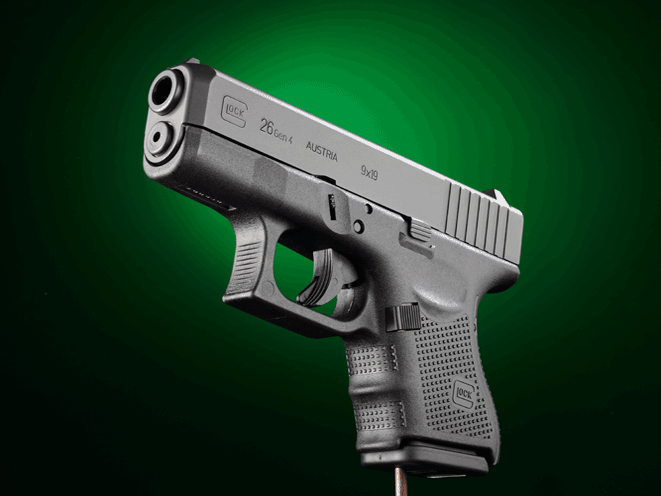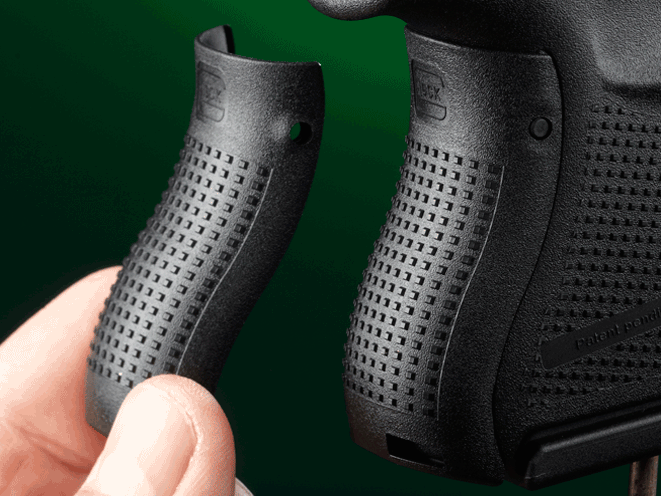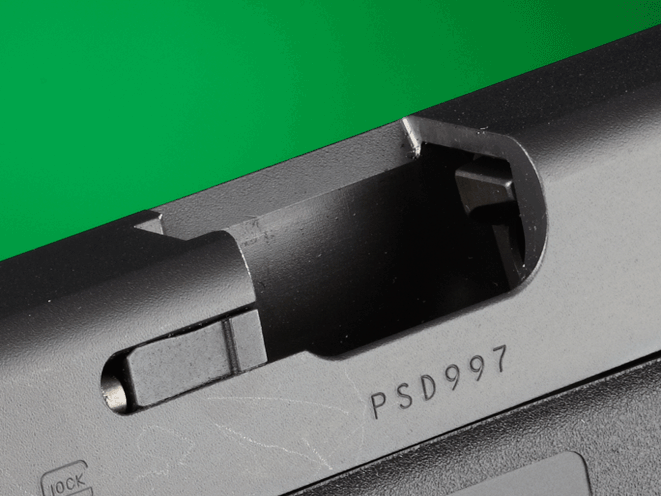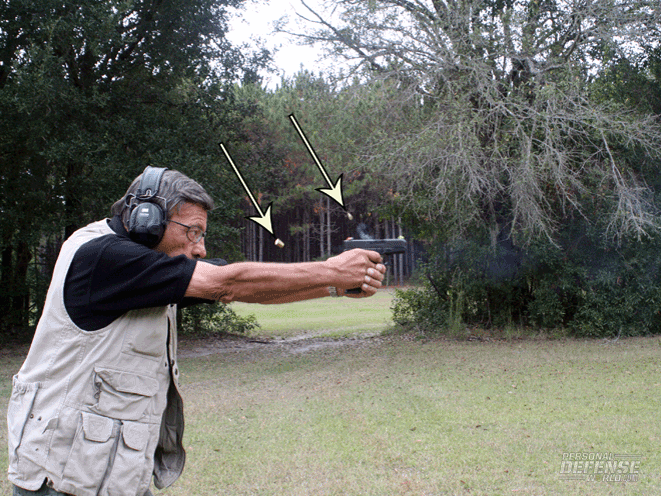Since its introduction circa 1996, the Glock 26 pistol has been hugely successful. Not just in the marketplace, but in the field. Essentially the modern classic Glock 17 “chopped and channeled” at the muzzle and butt, the Glock 26 is designed around a 10-round magazine and safely carries an 11th in the chamber. Of course, it also works with the 15-round magazine of the compact Glock 19, the full-length 17-round magazine of the standard-size Glock 17 and even the 33-round magazine originally developed for the Glock 18 machine pistol.
The 9mm Glock 26 was introduced simultaneously with its twin in .40 S&W, the Glock 27. For a while, they held apace in sales. Then, as the popularity of the .40 reached its peak, the Glock 27 outsold the Glock 26 for a time. Lately, though, my sources at Glock tell me that the Glock 26 is outselling the Glock 27. Meanwhile, the company later introduced the identical Glock 33 in .357 Sig, and even later, the Glock 39 in .45 GAP. Both areproven performers but are seen in the civilian market as “niche cartridges,” and neither has ever approached the 9mm or .40 in terms of popularity.
I now have three Glock 26s in the house. The oldest is one of the first that left the factory; I got it for a gun magazine test and liked it enough to buy it, along with the Glock 27 that came with it. Frankly, I liked the Glock 27 better. It was a tad more accurate, and I carried it a lot over the years as it came from the factory, save for adding Trijicon night sights and an NY-1 trigger. I carried .40s more than I carried 9mms back then. But the Glock 26 was my backup many times when I carried the Glock 17, as it would take the G17’s magazines and the advantage was obvious. For a while, it wore an 8-pound connector, since it wasn’t an everyday gun for me, and I wanted to have at least one Glock to demonstrate to students with every trigger option. Today, I use the Glock 26 more often than I used to. It has a standard Glock 5.5-pound trigger setup. I never did change the factory fixed sights on it—the white-dot front and square, white-outlined rear. After all, it shot where it was pointed. The last time I taught a class with it, it gave me a 300 out of 300 possible score on the pacesetter qualifi-cation, and I was content with that.
Advertisement — Continue Reading Below
The second Glock 26 in the gun safe at home is one that my girlfriend won at a Glock match. While the old one is a “Gen2” in Glock-speak, this one is a Gen3. Preferring her standard-trigger Glock 19 for carry, she set this one up with Ameri-Glo sights and a Glock OEM 3.5-pound connector, strictly for match shooting, such as in the Subcompact portion of Glock Sport Shooting Foundation (GSSF) matches and Back-Up Gun (BUG) events in IDPA.
The Glock 26 focused on in this article is a Gen4, which I won with my girlfriend’s Gen3 in Master Stock class at a GSSF shoot in Salt Lake City, Utah, in September of 2012. We had a match Glock 26 and a carry Glock 26, so I figured we’d round out the package with a fast Glock 26 that would be suitable for both carry and matches where a Glock 26 would be appropriate. For pure speed, I wanted “speed sights.”
I left the Glock 26 mostly stock, but had the new “night” version of WrenTech’s Advan-tage Tactical Sights installed. Bear with me, and I’ll explain why this combination was chosen, and how it worked out.
Advertisement — Continue Reading Below
Firefly Sights
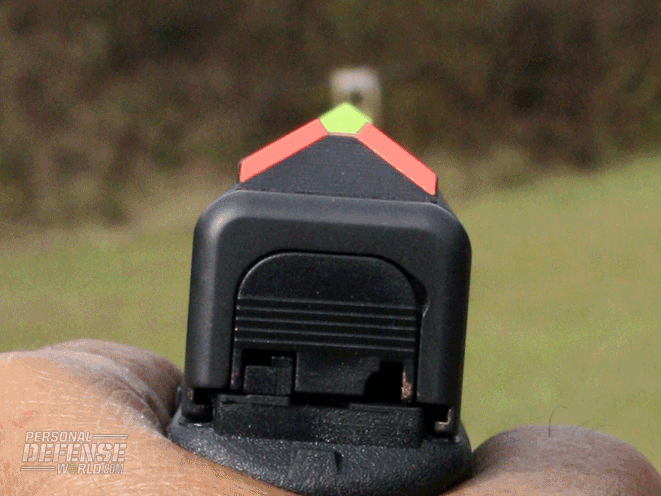
A few years ago, I discovered Advantage Tactical Sights from Richard Nasef at WrenTech. The sight picture is a pyramid image, converging bright lines at the rear capped by a bright spear point of a front sight. After taking a couple hundred rounds to get used to them, I found them very fast but also adequately precise. I’ve won IDPA matches with them since and carried them on the same Glock 17 Gen3. We who liked them kept asking Richard for a night-sight version. In November of 2013, that wish was granted in the form of the Firefly sight. The entire front sight is composed of resin mixed with crystal designed to “hold light.”
Related Stories: The Superstar GLOCK
Advertisement — Continue Reading Below
In July of 2013, the Advantage Tactical website posted the following comments on how the Firefly project was progressing: “The best part of all is that the Firefly exhibits the most extraordinary glow times. The following are functional tactical glow times that we have experienced when viewing the firefly from behind a firearm at an almost 180-degree angle (I say functional because the Firefly will glow for over 20 hours when viewed at a 90-degree angle): 2.25 hours with 10 seconds of exposure to a 90-lumen tactical light; 3.5 hours with 30 seconds of 90-lumen light; 7 hours of glow time with 90 seconds of sunlight.”
Subsequently, when the Firefly was in-troduced in November 2013, the company added, “Your Firefly night sight upgrade will swap out with any of our standard nylon front sights. Just out of the package, it may appear dull in color and will need charging before first use. The base colors—yellow spectrum and green spectrum—will change color slightly when exposed to a strong light source as they ‘charge.’ We recommend that you leave them in a source of good natural light for at least five minutes for the first charge. Firefly night sight inserts incorporate the latest chemical and manufacturing technology to glow in darkness. The more you use them, the brighter and longer they will glow.
“Firefly insert upgrades will glow for many hours with a short exposure to a strong light source—for example, one minute of strong sunlight exposure for an eight-plus-hour glow; positioning the
Advertisement — Continue Reading Below
Firefly 1 to 2 inches from a 75-watt lamp for 90 seconds for a six-hour glow. In addition, when the glow has finally diminished after many hours, just two seconds of a tactical light will bring back the glow for another 90 minutes or so.”
RELATED: Advantage Tactical Sight’s Firefly Night Sight
The company continues, “Charging will take longer with weaker light sources. Of course, any presentation of a partially charged Firefly insert to a strong light source will start the clock again for many more hours of glow. Though green Firefly sights with orange rear inserts and yellow Firefly sights with red rear inserts are recommended, please experiment with different color combinations.
Advertisement — Continue Reading Below
“Perception of glow depends on how quickly and how well your eyes adjust to darkness. This is especially so as the Firefly insert approaches the end of a glow duration. Younger eyes will adjust more quickly than older eyes. Freshly charged Firefly sights will spike very bright, then quickly settle down to maintain a plateaued glow for quite some time, as the glow steadily diminishes over many hours.
“In dusk and dawn periods, or if there is strong ambient light (i.e., from streetlights), the product may appear to glow less. The glow will become increasingly more apparent as the environment becomes darkened. The darker it is, the more pronounced the glow.
“As with our other products, over-tightening or over-torquing the Firefly setscrews may cause damage to the Firefly insert. After establishing a final zero, either blue or green Loctite is recommended. Expect decades of use with the Firefly, along with unwaning glow times,” the website concludes.
Advertisement — Continue Reading Below
Gun Details
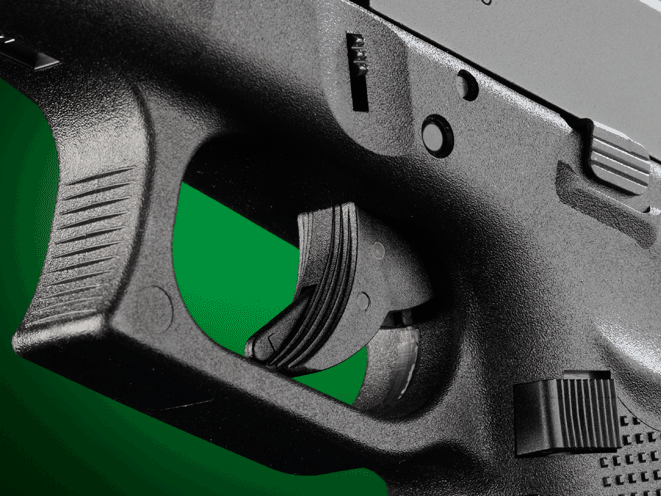
Way back in the 1990s when the Glock 26 first came out, I was impressed with its accuracy, as were most other reviewers. I found that, on the bench, it would group tighter than its big brother, the Glock 17. Curiously, though, the same subcompact in .40 S&W, the Glock 27, seemed to be even more accurate.
RELATED: Glock’s Next-Gen G41, 30S and G42 | VIDEO
Advertisement — Continue Reading Below
I always suspected that this might have something to do with the dual recoil spring assembly of the “baby Glock” design holding the barrel and slide in consistent battery until the bullet had cleared the muzzle, and that a proportionally thicker short barrel might be providing a bit more rigidity. Those first Glock 26s and Glock 27s were “Gen2s,” as Glock design progression is measured. We saw the same accuracy in the Gen3 iterations.
Glock brought the same dual recoil spring assembly design to the rest of its line, beginning with the full-size Glock 22 .40 and full-size Glock 17 9mm, as the Gen4s were phased in. Gen4 models also featured interchangeable backstraps, with the frame redesigned to bring the backstrap closer to the trigger. This shortened the critical hand fit dimension of “trigger reach.” Two inserts were included with each gun, which could quickly be attached to the backstrap. The pistol as it came from the box was essentially “size small.” A slim insert increased the grip girth and trigger reach to a “size medium,” pretty much the same as the standard Gen3 models that preceded it. Finally, the larger backstrap insert best accommodates the largest hands and the longest fingers.
It turned out that the “size small” dimension was the most user-friendly for a majority of shooters. When the Florida Highway Patrol (FHP) adopted the Glock 37 pistol in .45 GAP, it became the first department in the nation to get that gun in the Gen4 configuration. After intensively studying the research that led to the adoption and the efficient manner in which the FHP trained their personnel and deployed them in the field with the Glock 37, I stayed in touch with the agency’s firearms instructors. After the first year, they told me that approximately 90 percent of the troopers had left the backstrap inserts in the box and were carrying their Gen4 Glocks in what for all practical purposes could be described as the “size small” configuration. I’ve found myself doing the same with Gen4 Glocks, including the “baby” models.
Advertisement — Continue Reading Below
The trigger pull is subtly different on the Gen4 Glocks. It runs heavier. The reason: The reshaping of the grip altered the internal geometry of the mechanism just a little bit. Figure a pound or, at maximum, 2 pounds heavier than what you’d expect from the same model in Gen3. That said, though, I could live with the Glock 26 Gen4 and its 5.5-pound connector; the “roll” of the trigger was smooth, the break was clean and there was no perceptible backlash.
Range Time
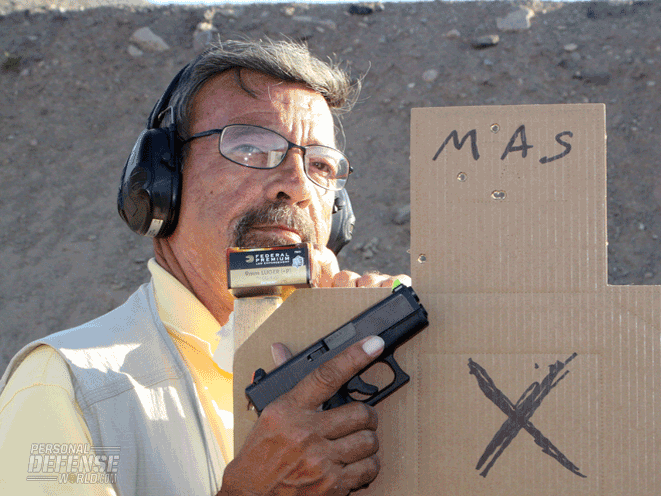
When the “baby Glocks” were first introduced in Gen4 format, I wrote them up for another magazine. Going back through my files, I found the group measurements from accuracy testing done from the bench on a Matrix rest at 25 yards. Using its factory sights, the Glock 26 Gen4 featured in that article, with Winchester 147-grain 9mm ammunition, created a 5.05-inch group for all five shots, with the best three grouping into 2.35 inches. The five-shot group with Black Hills 124-grain JHP ammunition measured 3.85 inches, with the best three clustering into 1.35 inches. Mag-tech’s 115-grain FMJ ammunition led the parade, putting all five shots into 1.8 inches and the best three into a frankly amazing 0.4-inch, one-hole group.
Related Stories: Vickers Elite Tritium Battlesight for Glock
The Glock 26 Gen4 I won at that match and tested for this article didn’t shoot as well out of the box. I was getting 5-inch groups when I gave it an initial test drive, and I set it aside to test later. Time ran out: My deadline was approaching when I had to take off for Arizona to teach a couple of classes. My friend Allen Davis, a Glock armorer, was kind enough to install the Firefly sights in time for me to shoot it for a few minutes, then get it into the suitcase and head for the airport.
That range session showed me that the Glock 26 shot 4 to 5 inches high and still wasn’t grouping as well as my earlier Glock 26 pistols. Once I got to Phoenix, the training crew there headed out with me to the range while the students were watching our safety movie. The gun shot high with those sights for all of us, and still wasn’t grouping the way we thought it should. Five of us, four of whom were Glock 26 owners, thought the groups were too big and the shots too high.
One of those test crew members was Phil Wong, also a Glock-certified armorer, and on the next day of training, while I was lecturing, he was kind enough to install every shim that came in the Firefly package to get the rear sight up higher to bring the shots lower. It wasn’t enough. The shots were still hitting well above point of aim.
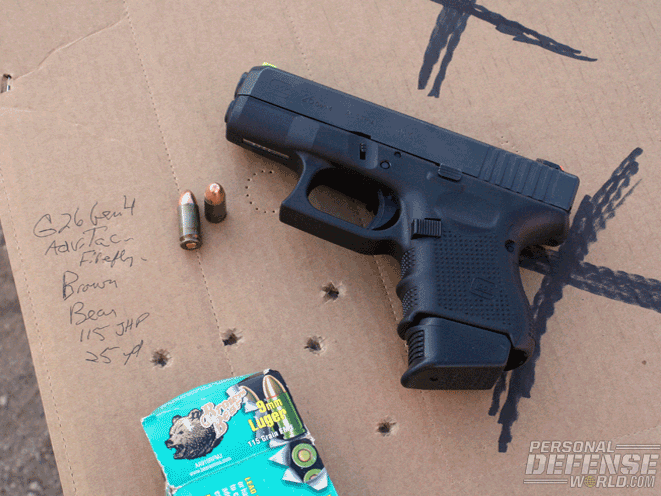
The pistol was breaking in and tightening up, though. During the next impromptu accuracy test, firing from a table at 25 yards but without a rest or sandbags, I only had a few minutes to shoot, and only two loads were tested.
One of those was the Federal HST 124-grain JHP +P ammunition. If memory serves, this is the choice of master instructor Todd Louis Green when he carries a 9mm, and it is most promising in ballistic testing. Holding for the top edge of the sternum on an IPSC silhouette to allow for the difference between point of aim and point of impact, I went for headshots. I felt myself jerk the trigger on the last of the five shots, and sure enough it went astray. I called it a Mulligan and fired one more shot so the gun and ammo wouldn’t be prejudiced by my lapse in trigger control. The result was five for five in the head, in a group measuring 4.88 inches. Four of those five were 2.19 inches, and the best three were all in the head box. The “best three” included two shots touching each other as a double, and the three bullet holes were 1.38 inches apart.
The other load tested with the Firefly/Glock 26 Gen4 combo was the Russian-made Brown Bear 115-grain FMJ. Strangely enough, this was the only load we fired through the pistol that went laterally from point of aim, distinctly to the left. However, the group made the service pistol accuracy standard of 4 inches at 25 yards, despite the short sight radius of a manufacturer-designated “subcompact” concealment gun as opposed to a full-size duty pistol. The five-shot group measured 3.88 inches, with four of the bullet holes 3.25 inches apart. However, the best three-shot group measured 1.94 inches.
Final Notes
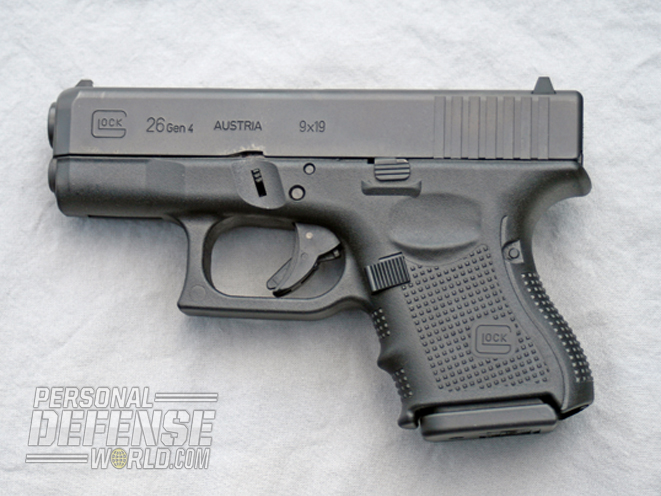
This Glock 26 Gen4 has been totally jam-free. Folks who hadn’t used the Advantage Tactical sights before didn’t like the Firefly, but those who had did. One student in that week’s class was a sergeant in a large sheriff’s department who carries her own privately owned/department-approved Glock 19C with Advantage Tactical sights as a duty pistol. She shot my Firefly-equipped Glock 26 and loved it, and told me she intends to order Firefly sights for each of her own Glocks.
The Glock 26 and the Firefly sights are proven performers. They go well together. Some more shimming under the front sight of mine and I think it will be where I want it to be. I’m happy with both. The MSRP for the Glock 26 Gen4 is $599. As to the Firefly sights, according to Richard Nasef, “One may purchase our regular Glock sight set, for example, for the same price they do now: $98.49. Or you may purchase the regular Glock sight plus Firefly for an additional $31. The total for that comes to $129.49. With each Firefly package one gets two Fire-flies—yellow spectrum and green spectrum. No doubt some will buy one standard sight set and one standard sight set plus the Firefly. That way they get two glowing sights that will hold their glow forever for $15.50 apiece, for those who have more than one pistol.”
Glock 26 Gen4 Specification
* Caliber: 9mm
* Barrel: 3.42 inches
* OA Length: 6.41 inches
* Weight: 19.75 ounces (empty) • Grips: Polymer
* Sights: Adaptive Tactical Firefly
* Action: Safe Action
* Finish: Black, surface-hardened • Capacity: 10+1
* MSRP: $728.49 (as tested)
For More Information
Glock
770-432-1202; glock.com
Advantage Tactical Sights
310-316-6413; advantagetactical.com
